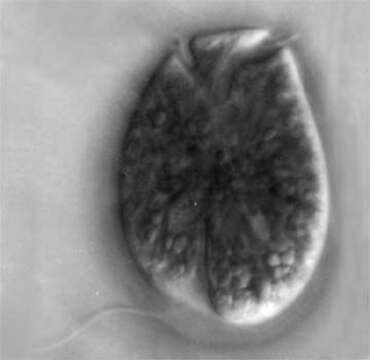portrait

Description:
Cells ovoid to egg-shaped, length 29 - 48 microns, width 21 - 28 microns, length to width ratio 1.4 - 1.6. Dorso-ventrally flattened. Epicone 7 - 10 microns wide, anteriorly flat, with the right anterior corner almost a 90 degree angle and the left corner extended into a 30 degree- 45 degree angle. Cingulum relatively deep, beginning 0.2 - 0.3 of the cell length from the apex, initially rising abruptly, continuing almost horizontally around the cell, proximal end slightly higher than distal. Hypocone rounded, slightly asymmetrical, right side more curved than left. Sulcus relatively deep, beginning just to the right of the mid-ventral line, 0.6 - 0.7 of the cell length from the apex, initially narrow, then widening at the posterior end. Apical groove not present. A narrow ventral ridge runs between the two points of flagellar insertion. Two pusules present: one obvious, approximately 2 microns diameter, to the right of the origin of the sulcus, the second less obvious, also 2 microns diameter, just below and to the left of the proximal end of the cingulum. Chloroplasts in long thin strands, yellow-brown. Nucleus in the posterior part of the hypocone, crescent shaped or oval 8 - 10 x 12 - 18 microns, containing very fine chromosomes. Division is by binary fission in the motile cell. A red-orange body, either a food particle or eyespot, occasionally present just anterior to the nucleus. Colourless globules present in some cells.
Included On The Following Pages:
- Life (creatures)
- Cellular (cellular organisms)
- Eukaryota (eukaryotes)
- SAR (Stramenopiles, Alveolates, Rhizaria)
- Alveolata (alveolates)
- Dinophyceae
- Gymnodiniales
- Gymnodiniaceae
- Amphidinium
- Amphidinium operculatum
- Dinoflagellata (dinoflagellates)
This image is not featured in any collections.
Source Information
- license
- cc-by-nc
- author
- Shauna Murray
- provider
- micro*scope
- original
- original media file
- visit source
- partner site
- micro*scope
- ID


